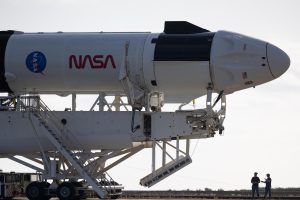NASA and SpaceX have signed a Space Act Agreement to study the feasibility of boosting the orbit of the iconic Hubble Space Telescope, potentially ensuring that the highly successful observatory will remain operable well into the middle of this century.
Thanks to three servicing missions completed in the 1990s and 2000s, Hubble remains highly productive more than 32 years after its launch. NASA believes that that will remain the case until at least the late 2020s or 2030s. However, many components of the telescope have spent decades in the unforgiving environment of space, raising unsurprising concerns about their longevity.
More importantly, the inexorable march of time, gravity, and Earth’s atmosphere mean that Hubble is guaranteed to eventually reenter that atmosphere and burn up without intervention. That demise could come as early as the mid-2030s, but SpaceX thinks it could help extend the telescope’s viability into the 2050s.
NASA and SpaceX will spend the next six or so months discussing whether it’s possible to use Dragon to boost the telescope’s orbit back to a nominal 600 kilometers (~372 mi). Both parties say that the agreement will also investigate the possibility of Dragon servicing missions, which could be even more significant for Hubble. While a boost that large would likely keep it in orbit for decades to come, there’s no guarantee the telescope would remain functional to take full advantage of the extra time it would have.
During the fifth and final Space Shuttle servicing mission, NASA astronauts installed a docking adapter (Soft Capture Mechanism) on the Hubble Telescope. Although no concrete plans existed for any additional servicing missions, the forward-facing installation of that adapter has made this feasibility study possible.
In theory, that docking adapter could make boosting Hubble’s orbit far more feasible, safe, and affordable than a Shuttle-style crewed servicing mission. SpaceX’s Cargo Dragon 2 spacecraft has the same autonomous docking capabilities its crewed sibling has and costs less to launch and operate, so it’s not inconceivable that an uncrewed Dragon could autonomously dock with Hubble and boost its orbit. Jessica Jensen, SpaceX’s Vice President of Customer Operations and Integration, says that an uncrewed option will be studied alongside crewed servicing and orbit-boost alternatives.

According to Patrick Crouse, NASA’s Hubble Space Telescope project manager, without a reboost, NASA would need to consider a separate mission to ensure a controlled deorbit of the massive telescope by “the end of the decade.” The study’s targeted boost of “40 to 70 kilometers,” meanwhile, could extend the longevity of Hubble’s orbit by “15 to 20 years,” or well into the 2050s. But as a feasibility study, there’s a chance that it will conclude that using Dragon – crewed or uncrewed – to boost or service HST isn’t feasible. Ordinarily, the most likely outcome would be a conclusion that the project is feasible from a technical perspective but out of reach from a financial perspective.
Enter billionaire and private astronaut Jared Isaacman, who was directly involved in the September 29th press conference. In September 2021, Isaacman – alongside four others – became the first all-private astronaut mission in history to reach orbit. After the spectacular success of Inspiration4, Isaacman’s relationship with SpaceX has become even closer. In early 2022, the pair announced a new endeavor – the Polaris Program – that intends to conduct at least two or three more private astronaut launches over the next few years.
Expanding the scope of their joint ambitions, the Polaris Program intends to debut the world’s first privately developed EVA spacesuit, test spacecraft-to-spacecraft communications using Starlink’s network of space lasers, and culminate in the first crewed launch of SpaceX’s next-generation Starship rocket. On its own, the decision to privately fund and develop an EVA suit and pursue the ability to conduct EVAs out of Crew Dragon represents a major leap forward for SpaceX and private spaceflight if realized.
But crucially, when asked about the synergies between the Polaris Program, SpaceX, and NASA, Isaacman revealed that he and SpaceX are willing to undertake a sixth Hubble servicing mission more or less pro bono, “with little or no potential cost to the government.” According to Isaacman, it’s possible that “the study could result in [a Hubble servicing mission] becoming the second [Polaris Program] mission.”
Polaris Dawn, the program’s first mission, was recently delayed from a late-2022 launch target to March 2023. The four private astronauts assigned to the mission (including Isaacman himself) recently began training for the historic private EVA, which will see two of four astronauts attempt to briefly exit their Crew Dragon spacecraft in new SpaceX-designed suits. With a targeted apogee of 1400 kilometers (~870 mi), the mission will also attempt to break the record for the highest Earth orbit reached by astronauts, and the spacewalk attempt will also occur at a record-breaking altitude of 700 kilometers (~435 mi)





